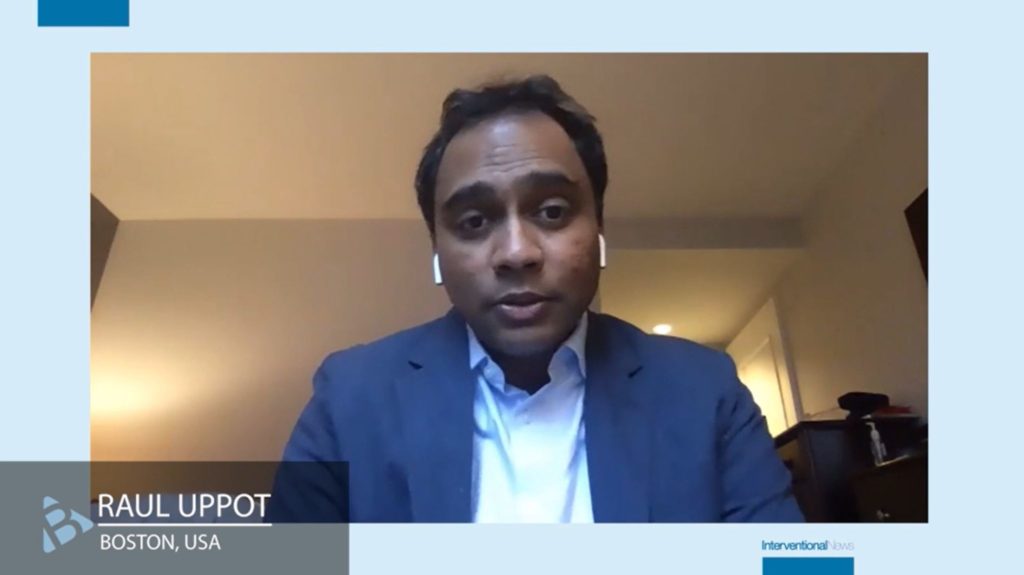
Speaking during a livestreamed session dedicated to state-of-the-art liver therapy hosted by the Symposium on Clinical Interventional Oncology (CIO) on Tuesday 6 October, Raul Uppot (Massachusetts General Hospital, Boston, USA) discussed the evolution of liver ablation, from the first procedure in November 1986—where the patient was injected with alcohol into liver tumours—to the potential of this treatment modality to offer systemic, curative cancer care, possibly even without inserting a single needle. Here, he shares his thoughts on the past, present, and future of ablation with Interventional News.
What are the benefits of ablation of the liver, and are there any downsides?
The beauty of ablation is that, in a very minimally invasive way, you can treat tumours. In the past, when we were just doing biopsies, it was amazing to us that you could put a needle directly into the target to sample it for diagnostic purposes. Since the late 1980s, we have moved towards being able to treat tumours in a similarly minimally invasive fashion. The ability to use CT or ultrasound to put a small needle into something, to completely treat a tumour that previously would have required surgery, pull the needle out, put a band aid on, and send the patient home—that is what is unique about ablation.
Ablation allows you to treat tumours in a minimally invasively fashion, and we now have the data to show that the ability to do that has long-term impacts on our patients. As with any procedure that we do, there are risks. There are the same risks that you would have with any procedure: bleeding, infection, injury to adjacent organs.
How has the use of hepatic ablation changed over time?
The first hepatic ablation involved the insertion of a small needle into a tumour that was then injected with alcohol. People realised that alcohol could destroy tissue, so thought ‘Why not kill tumours by injecting alcohol into them?’ Since then, we have developed more advanced equipment that can burn or freeze tumours.
The applications have evolved as well. We initially treated primary hepatocellular tumours, and, over many studies, we have shown that [ablation] is very successful at local control and improving overall survival in patients. But we have also evolved into other tumours, such as treating metastatic disease. I think an exciting part of interventional radiology (IR) now is the ability to treat metastatic disease: colorectal cancer, pancreatic cancer, breast cancer metastases to the liver. Management of all of these tumours are based on a background knowledge from the surgical literature. For example, if you were able to surgically debulk disease in the liver for certain cancers (such as colorectal cancer), then you could improve survival. The same data is now being applied to IR, where, if you can debulk as much of the tumour in the liver, then you can potentially improve overall survival.
What is the evidence for ablation in the treatment of liver metastases?
I think the biggest trial out there that we are excited about is the COLLISION trial—this is a trial that will compare the treatment of colorectal cancer metastases with ablation versus surgery. The trial started in 2017, is expected to recruit 600 or so patients, and has a planned end date of 2022. The strength of this trial is that it is a multicentre, randomised controlled trial that will try to answer the question: is ablation as good or better than surgical resection, the current gold standard?
Given our historical data on ablation, especially for the treatment of hepatocellular cancer, we know that we can treat tumours with a good margin, so the expectation is that, in much the same way as surgery has improved survival in terms of debulking metastases disease to the liver, ablation could probably do the same thing, but with lower costs, less hospitalisation time, and with an equivalent survival to surgically treated patients.
What does the future of ablation look like?
When ablation first started, our goals were really just to provide a good option for locally controlling liver tumours. I do not think that the first time an ablation was done, there was ever any belief that we would treat widespread, systemic disease with a single probe. So it is very exciting now to learn that certain tools we now have, such as irreversible electroporation (IRE) and cryoablation, can potentially incite systemic effects. There are now a lot of trials going on exploring the combination of immunotherapy drugs and ablation.
I think where ablation fits into this whole paradigm is that, by destroying the tumour, you are able to release antigens; the release of these antigens, combined with immunotherapy drugs, could potentially affect overall systemic disease. I personally have had a few patients where treating a single tumour in the adrenal glands or the kidneys has ultimately resulted in a decrease in size of metastatic tumours in other parts of the body. This was accidental—we call it an abscopal effect. I think this has happened enough times that people have realised there is a way to study this, there is a way to learn how this could potentially be occurring, and control it, and use immunotherapy drugs to help it, so it is exciting, because I think for the first time it is a whole new world for IR. The ability to put a needle into one lesion, treat that, yet somehow affect systemic tumour control everywhere else, and improve overall survival in the patient.
What is the key message you would like your IR colleagues to take home from your CIO presentation on liver ablation?
What I want people to know is that liver ablation started off as a small trial: can we kill a tumour with a small needle? Over the past 30 years, we have shown that that is possible. It is exciting that, using a small probe, you can insert it into the liver and impact care: completely treat large tumours, multiple tumours, and yet the patient goes home as an outpatient with just a band-aid. The ability to do great oncological care and work with a small needle is exciting about ablation.
The other thing I am very excited about is that, over time, there has been a constant evolution in the technology [for ablation]. We started off with alcohol, but we evolved to radiofrequency ablation (RFA), cryoablation, microwave ablation, and IRE. There is a constant evolution in these technologies: we are constantly moving towards smaller and lighter probes that are more efficient in what they can destroy. There are new technologies on the horizon, such as histotripsy, that allow one to treat a tumour without inserting a needle. The ability to use ultrasound waves to kill tumour [cells] is what is coming down the pipeline. It is very exciting, the notion that a person could come in with a large liver tumour and one could treat it in a very minimally invasive fashion and, ultimately, improve the patient’s survival.










